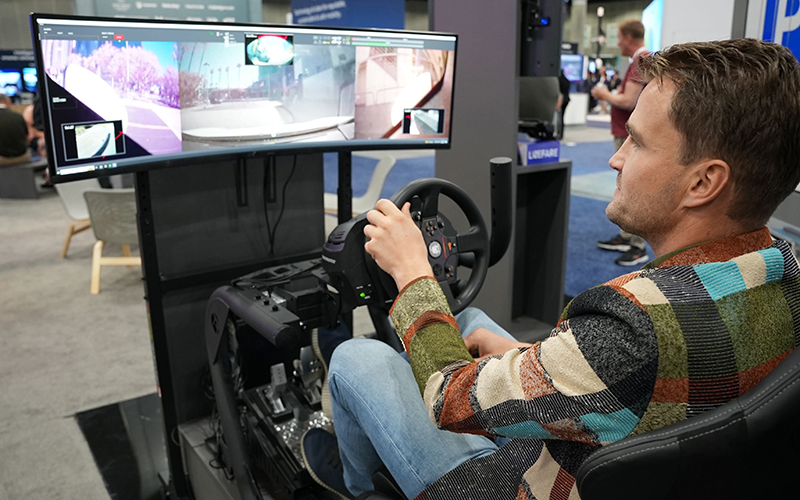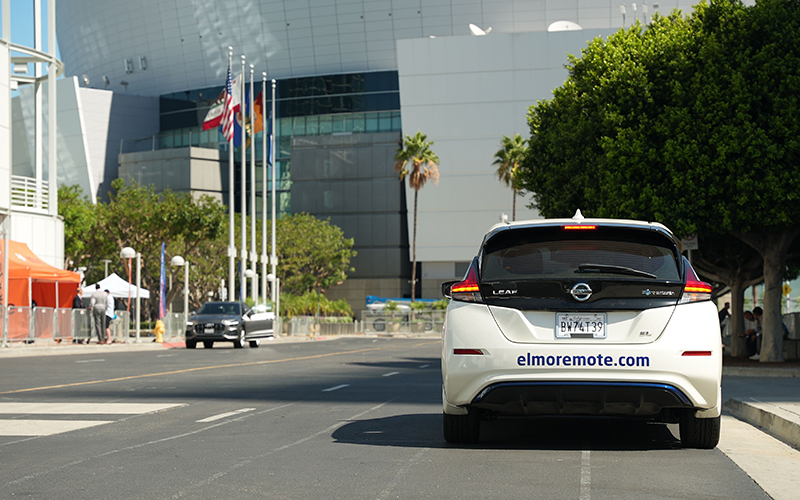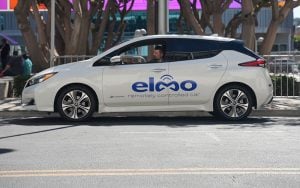
Enn Laansoo, co-founder and CEO of Elmo, demonstrates the remote technology available on the company’s rental vehicles at the ITS World Congress in Los Angeles on Sept. 20. (Photo courtesy of Elmo)

A closeup of the steering wheel of the remotely controlled rental vehicle that Elmo demonstrated at the ITS World Congress. (Photo courtesy of Elmo)

A rental car from Elmo sits outside the Los Angeles Convention Center, where the ITS World Congress met this month. (Photo courtesy of Elmo)
LOS ANGELES – To the casual observer, this electric rental car whizzing by looks like yet another test of a self-driving car. After all, no one’s behind the wheel.
But actually, someone is driving the car – only they’re doing so from miles away. And that’s what makes this business model stand apart from the many other autonomous vehicle operations.
The car is being driven remotely from a building where an operator uses cameras in the car to see where it’s going and can steer, brake and accelerate.
“We can make remotely controllable cars (for) any kind of electric vehicle,” said Enn Laansoo, CEO and co-founder of Elmo, a car-rental company based in the small Baltic nation of Estonia that’s pioneering the technology.
Self-driving cars have become increasingly common in a few cities, including Chandler, Arizona, one of the few jurisdictions in the country that allows them. Gov. Doug Ducey encouraged makers of self-driving cars to test in the state. But the safety record of autonomous vehicles hasn’t been perfect, which is slowing a wider rollout.
Self-driving cars have figured in two fatal accidents, including one in Tempe in 2018, as well as fender benders.
Elmo thinks it has a solution.
Having a remote driver – a real human behind the wheel, though not in the car – amounts to a bridge technology that could make sense until the bugs can be completely worked out of autonomous cars.

Elmo rents Nissan Leaf electric cars that can be driven remotely from one customer to the next. (Photo courtesy of Elmo).
Plus, there’s a business advantage. Laansoo said having a remote operator move cars from one customer to the next creates cost savings while mitigating some of the danger of autonomous cars. Elmo aims to make rental car deliveries more convenient.
Instead of customers having to come to an Elmo office to pick up a car, the company uses the remote operator to deliver one directly to a customer’s doorstep, said Laansoo, who showed off the technology last week at the ITS World Congress in Los Angeles.
Customers can use the vehicle as a normal rental car. When they no longer need it, they park it and the remote operator drives to another user.
“Once you don’t need it … it’s serving another customer, so it’s in circulation,” said Raili Somelar, chief marketing officer at Elmo. “So it saves time and energy.”
Elmo began renting out its not-so-self-driving cars in Estonia this year and plans to expand to Germany and France. It’s also exploring how to use the technology to allow electric-car owners to add their cars to Elmo’s rental fleet and get compensated.
“You can put your own car into circulation while you’re working or while traveling and you don’t need your car,” Somelar said. “So somebody else can carpool it and you can still get paid.”
The process would be mostly the same. A remote operator could deliver your car by looking at a video screen. On the steering wheel, users can activate the transmission, headlights and windshield wipers.
The driver’s seat has six cameras: three on the front, one on the back and two to the side. On a video screen miles away, the operator can see what gear the car is in and whether the parking brake is engaged.
With Elmo’s remote control technology, Laansoo said, one operator can switch between handling as many as 10 cars at once.
This kind of car sharing could reduce the number of vehicles in the street. And if those cars are self-driving, proponents say, riders could be safer considering most traffic accidents are human-caused. Autonomous cars also can communicate with one another to avoid traffic jams.
“Anything that’s helping people be mobile, to make the journeys they want to make, is the most convenient way,” said Bernard Tabary, CEO of the global transportation-systems company Keolis, who attended the ITS World Congress.
One obstacle to autonomous vehicles is that people aren’t yet fully comfortable with the idea. In 2019, AAA found that 71% of people surveyed indicated they’re afraid to ride in fully autonomous vehicles. And even if they don’t use ride-sharing themselves, many respondents still didn’t want these vehicles on the road.
In Tempe in March 2018, Elaine Herzberg, 49, died after she was struck outside a crosswalk by an SUV being operated in self-driving mode as part of Uber’s autonomous vehicle testing. A “safety driver” who was supposed to intervene to prevent accidents was behind the wheel, according to news reports at the time.
It will take some time for people to adjust to fully self-driving cars.
“We have test fleets of autonomous taxis where you can try this out,” said Andreas Braasch of the University of Wuppertal in Germany, at the ITS conference. “When you’re sitting in the car and you see that it’s working, and it’s nice, then you say, ‘Oh, that’s cool.’”

